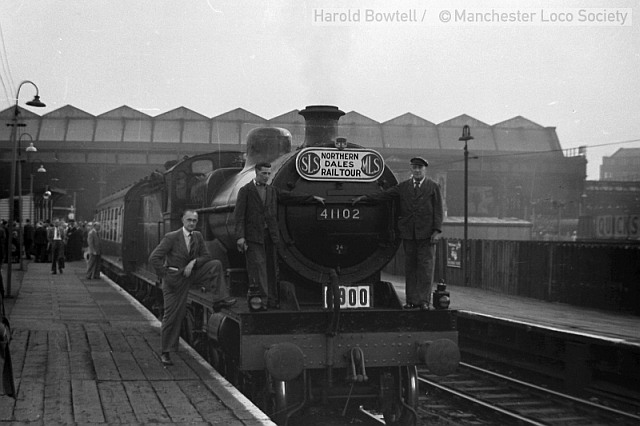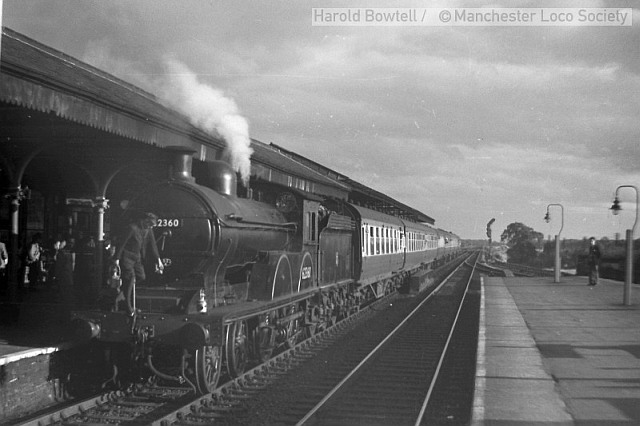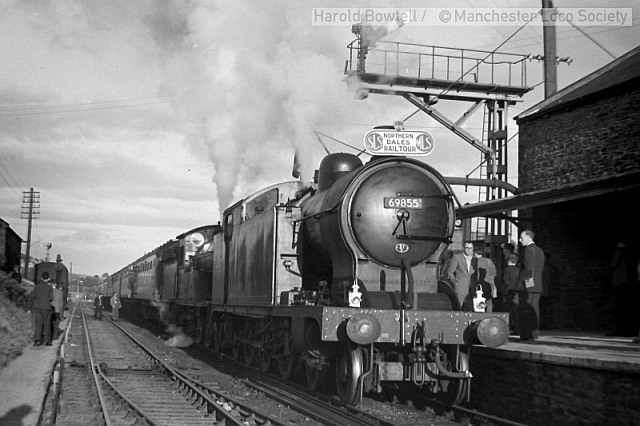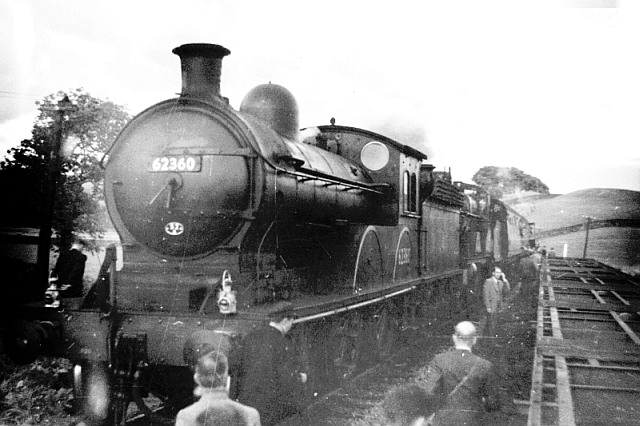Return to Railtour list
THE SLS/MLS RAILTOURS
10. The Northern Dales Railtour September 4th 1955

This tour was considered by many members to be one of the best which the SLS/MLS Railtours Sub Committee ever ran. It was the tenth to be promoted jointly by the two Societies and carried 351 passengers a total of 273 miles over two of the highest railway summits in the north of England.
An excellent 20-page itinerary was prepared by Gerald Harrop and J.W.Armstrong which gave a history and description of all the lines over which the train travelled. The article below is based on a report published in the Society magazine The Mancunian issue 98 (1980), on the 25th anniversary of the event, which was reprinted with more detail in issue 248 (2005).
The Journey
The eight coach train started from Platform 14 at Manchester (Victoria) at 9.23am and was headed by a Blackpool "Compound" No.41102 which was only recently out of Derby Works after overhaul and carrying reporting number C900. It was in the hands of Driver Fred Mountfield who was regarded as one of the most resourceful of Newton Heath’s Glasgow express link, and Fireman A. Nokes, also of Newton Heath. This crew worked the "Compound" all day with a rest of about three hours at Hellifield.
The first booked stop was Blackburn and after running slowly through Bolton (Trinity St) station and round the curve on to the Blackburn line,climbed the 5½-miles to Sough Tunnel on a ruling gradient of 1 in 71 in good style,despite the fact that the rail was damp with light rain. The minimum speed up the bank was 20 mph through Turton. There was some delay on the descent through Darwén because of single line working and consequently arrival at Blackburn was a little late.
Blackburn was a picking up point for Railtour passengers, but some ordinary passengers bound for Darlington were also put on the train by the station staff. These people soon became amused at the antics of some of their fellow travellers, then rather worried about where they were going when it became apparent that they were running through unfamiliar areas. It is 2.9 miles from Blackburn to Wilpshire,mostly uphill at 1 in 127/162 and 1 in 75 at the top, and this took 7 minutes 48 seconds with a speed of 32 mph at the summit. From here the line falls at 1 in 82 and 1 in 89 for 4½ miles and on this stretch speed rose to 71½ mph before a slack through Whalley. In all,the "Compound" took 35½ mins to reach Bellifield, 24¼-mi1es from Blackburn. Here, passengers from the West Riding and Lancaster joined the train ,and then it set off northwards again to its next booked stop at Tebay.
At Clapham the tour train took the "Little North Western" line to Ingleton where the substantial station (ex Midland) still had its bay platform on the Up side for the Clapham trains. Also,the single road wooden engine shed was still standing on the right hand side of the line before Ingleton station. North of the viaduct the remains of the old LNWR station could be seen (Closed on 1.1.1917), but all trace of the LNWR shed and turntable had disappeared. Then, in heavy rain and with low cloud obscuring.the hilltops, the train joined the L.N.W.R. main line at Low Gill and on through the Lune Gorge to reach Tebay station.
Here the "Compound" was detached and ran back light to Hellifield shed,
replaced at the front of the train by two engines, No.65061, a Class J21 0-6-0 built at Gateshead in 1890, withdrawn in 1939 but reinstated in 11/1959, piloting 46478, a Class 2MT 2-6-0 built at Darlington in 1951. Driver Wigglesworth and Fireman Cheetham were on the 0-6-0 and Driver Swires and Fireman Cassidy on the "Mogul" whilst the Shed Master from Kirkby Stephen, Mr.Keating,travelled as well as far as his home base.
There were four locomotives on the LNWR shed at Tebay, 2-6-4Ts 42404/24,both of Tebay shed, 4F 0-6-0 44083, a1so of Tebay, and ex LNWR 0-8-0 49079. The remains of the ex N.E.R. locomotive shed, closed in 1903, could still be seen to the right of the station.
From Tebay, the train headed up the Lune valley past Gaisgill and Ravenstonedale where the track became single to Kirkby Stephen Junction. Then, after passing under the Midland's Smardale viaduct,we passed the site where, about four months earlier,a couple of Class Q6 O-8-Os working a train of mineral empties and running tender first from Tebay were thrown off the track and the leading locomotive, No.63555 rolled down the embankment. The other "Q6" No.65373, whilst being derailed, managed to stay upright, but traces of the accident could still be seen. On arrival at Kirkby Stephen, the train stopped and the passengers were able to visit the shed which contained fairly modern engines,viz:
Ivatt Class "4MT" 2-6-0 43038/55 43122/24/28/50
Ivatt Class "2MT" 2-6-0 46470/72
BR. Class "2MT" 2-6-0 78017/19
BR. Class "3MT" 2-6-2T 82026/27
The run over the top from Kirkby Stephen to Darlington (North Road) took 77 minutes for the 38.3 miles and was completed non stop although over Belah viaduct speed was reduced to about 10 mph which greatly aided observation over this spectacular structure. Speed then recovered to about 22 mph at Stainmore Summit, 9.5 miles from Kirkby Stephen and 1370 feet above sea level. Speed downhill reached a maximum of 47 mph before Barnard Castle.
At Darlington most passengers elected to visit the Locomotive Works and the arrangements made by the Works Manager were greatly appreciated. Classes represented in the Works Yard and Erecting Shop incloded Class J71 O-6-0Ts from the T.W.Worsdell era, Classes J72, J25, J26 and J27 of Wilson Worsdell design and Classes A8, B16 and Q6 turned out by Mr. Raven. Also on view were Class D49 4-4-0s, V2 2-6-2s and 2-6-2Ts of Classes V1 and V3 which came out under the Gresley regime.
The more recent types were represented by B1 4-6-Os, Class L1 2-6-4Ts and WD 2-8-Os. In the Works Yard were the spare frames and cab from No.6l434(ex B16 No.2363) which had been rebuilt from B16 to "B16/3S" in 1949 on new frames. New engines under construction included Diesel shunters 13161-66 and 2MT 2-6-Os Nos 78045-47. The scrap yard contained 62384 (D20), 68238 (J71), 69577/81 (N8)and 68155 Y3).
Darlington was the destination of the tour and the return journey started from the east end of North Road station over the original Stockton and Darlington line,opened on 27.9.1825. A Class A8 4-6-2T No. 69855 was now at the front with Driver Poole and Fireman Collinson in charge. First the train crossed the East Coast main line on the level at S & D Crossing Box, with a glimpse of the original locomotive shed of the Great North of England Railway, which was still intact. Then running was on the wrong line as the left hand track was being used to store goods vehicles, past Fighting Cocks station which was closed on 1.7.1887 and the site of Dinsdale Ironworks to join the Darlington to Saltburn line at Oak Tree Box.
Then on to Eaglescliffe where the train reversed. It had to be crossed over facing junctions to the Up side before reversal could take place and all the passengers were asked, somewhat hurriedly, to detrain before this manoeuvre took place; some well-known figures were rather surprisingly seen carrying trays of ham and salad,only just acquired from the cafeteria car, across the tracks of the erstwhile Leeds Northern line, in order to regain their accommodation on the other side. Then we set off for Northallerton, with the A8 running bunker first.

The train reversed again at Northallerton (above)and an old friend in the form of Class D20 4-4-0 No.62560 came on to the front. This engine had been built at Gateshead in 1900 as No.21O1, rebuilt by the LNER in 1942 and was at this time shedded at Alnmouth. This particular engine had come down from Northumberland on 24.8.1952 to work the SLS / MLS special over the Hull & Barnsley line from Cudworth to Hull and back, and the two Societies had put in a special request for it to be used on the 'Northen Dales' train. The request was granted and Driver Watson and Fireman King of Northallerton were on the footplate.

The A8 was then put on as pilot and the two locomotives took the train up Wensleydale as far as Hawes, with a stop at Leyburn (above). From Darlington the weather had improved and was now perfect so the dale certainly looked its best. At Hawes the two North Eastern locomotives came off and were replaced by the Compound No.41102. The line westwards from here was of course built by the Midland Railway and opened on 1.10.1878 so it was right to have a locomotive of Midland design.

Hawes.
The A8 then returned along Wensleydale to Northallerton but the D20 was attached as pilot to the Compound and the two locomotives made a storming run over the steep 5.9 miles to the bleak junction at Garsdale.
Here we said "Good-bye" to the N.E.R. 4-4-0 and set off for Manchester with the Compound in sole charge. Maximum speed on the down hill run from Blea Moor was 75 mph after Settle after which there was a smart run from Hellifield to Blackburn where the train stopped to set down. The final run through Darwen and Belton brought the "Northern Dales" train into Victoria about 15 minutes late to end a superb and memorable trip.
A note by Harold Bowtell from issue 99
The account in Mancunian 98 brings memories of that eminently rewarding day which was magnificiently carried through by the B.R. people in accordance with the plan which we of the SLS/MLS had worked out,and which gave such pleasure to the many participants. It was our tenth joint tour since James Boyd and I met Mr.R.C. Flowerdew at Hunt's Bank in October 1950 and opened negotiations which led to this tour and its successors.
As an enthusiast for the North Eastern Railway and its territory, I could not rest content with our modest incursions into the N.E.R. area, but one key figure at York proved obdurate, and all my efforts were in vain. Eventually, I discussed the problem.in London with Jack Boston, then the Chairman of the S.L.S. and today its President; he, with Alan Pegler, broached the subject on our behalf with the General Manager of the North Eastern Region during an informal chat over refreshments at the King's Cross Hotel.
I was soon cordially received at York and this tour was the first outcome, followed by our several ensuing tours in the North East. Alan Pegler remained a good friend and it was a great pleasure to work with him on the three tours which we ran behind his locomotive Flying Scotsman in 1964, 1966 and 1968. We nearly had another one from Manchester to Bressingham but the "Scotsman" mission to the U.S.A. intervened.
Last update January 2024. Comments welcome: website@manlocosoc.co.uk